
HMS Legion was an L-class destroyer of the Royal Navy. She entered service during the Second World War, and had a short but eventful career, serving in Home waters and the Mediterranean. She was sunk in an air attack on Malta in 1942. The ship had been adopted by the British civil community of the Municipal Borough of Cheltenham, Gloucestershire in November 1941.
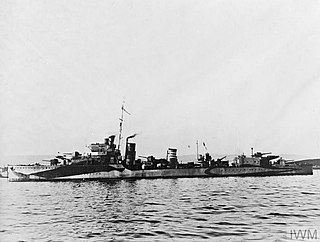
HMS Faulknor was the flotilla leader for the F-class destroyers built for the Royal Navy during the 1930s. The ship had a particularly active operational role during World War II, being awarded 11 battle honours, and was known as "The hardest worked destroyer in the Fleet". She was the first ship to sink a German U-boat, took part in the Norwegian Campaign, served with Force H in the Mediterranean on the Malta Convoys, escorted convoys to Russia and across the Atlantic, and saw action during the invasions of Sicily, Italy and Normandy, and was at the liberation of the Channel Islands. She was then decommissioned and sold for scrap in late 1945.

HMS Quail was a Q-class destroyer of the Royal Navy. She served during the Second World War but her career lasted less than a year before she was damaged by a mine and withdrawn from active service.

HMS Escapade was an E-class destroyer built for the Royal Navy in the early 1930s. Although assigned to the Home Fleet upon completion in 1934, the ship was attached to the Mediterranean Fleet in 1935–1936 during the Abyssinia Crisis. During the Spanish Civil War of 1936–1939 she spent considerable time in Spanish waters, enforcing the arms blockade imposed by Britain and France on both sides of the conflict. Escapade was assigned to convoy escort and anti-submarine patrol duties in the Western Approaches when World War II began in September 1939, but transferred back to the Home Fleet at the end of the year.

HMS Forester was one of nine F-class destroyers built for the Royal Navy during the early 1930s. Although assigned to the Home Fleet upon completion, the ship was attached to the Mediterranean Fleet in 1935–36 during the Abyssinia Crisis. A few weeks after the start of World War II in September 1939, she helped to sink one German submarine and then participated in the Second Battle of Narvik during the Norwegian Campaign of 1940. Forester was sent to Gibraltar in mid-1940 and formed part of Force H where she participated in the attack on the Vichy French ships at Mers-el-Kébir and the Battle of Dakar between escorting the aircraft carriers of Force H as they flew off aircraft for Malta and covering convoys resupplying and reinforcing the island until late 1941. During this time the ship helped to sink another German submarine.
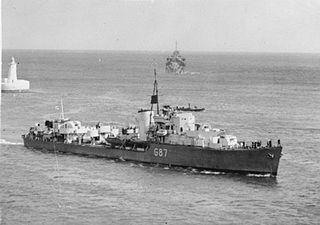
HMS Lance was an L-class destroyer of the Royal Navy. She entered service during World War II, and had a short but eventful career, serving in Home waters and the Mediterranean Sea. She was damaged in two consecutive air attacks at Malta in 1942. She was towed back to Britain, declared a constructive total loss and was scrapped. She had been adopted by the civil community of Bexley and Welling, Kent in November 1941.

HMS Laforey was an L-class destroyer of the Royal Navy. She was commissioned in and served during the Second World War, and was torpedoed and sunk by a U-boat in 1944. She had been adopted by the civil community of Northampton in November 1941.

HMS Arrow was an A-class destroyer of the Royal Navy. She served during the Second World War before being damaged while fighting a fire on an ammunition ship and written off in 1943.

HMS Tetcott was a Type II British Hunt-class destroyer built for the Royal Navy during World War II. She was the only Royal Navy ship to be named after the Tetcott fox hunt.

HMS Badsworth(pennant number L03) was an escort destroyer of the Type II Hunt class. The Royal Navy ordered Badsworth's construction three months after the outbreak of the Second World War. Cammell Laird laid down her keel at their Birkenhead yard on 15 May 1940, as Admiralty Job No. J3260. After a successful Warship Week national savings campaign in March 1942, Badsworth was adopted by the civil community of Batley, then in the West Riding of Yorkshire. The ship was named after a fox-hunt in Yorkshire.
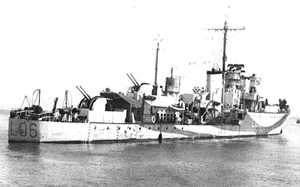
HMS Avon Vale(pennant number L06) was an escort destroyer of the Hunt Type II class. The Royal Navy ordered Avon Vale's construction three days after the outbreak of the Second World War. John Brown Shipbuilding & Engineering Company Ltd laid down her keel at their Clydebank yard on 12 February 1940, as Admiralty Job Number J1569. After a successful Warship Week national savings campaign in February 1942, Avon Vale was adopted by the civil community of Trowbridge, Wiltshire.

HMS Blackmore(pennant number L43) was an escort destroyer of the Type II Hunt class. The Royal Navy ordered Blackmore's construction three months after the outbreak of the Second World War. A. Stephen & Sons laid down her keel at their Glasgow yard on 10 February 1941, as Admiralty Job Number J1479. The ship was adopted by the civil community of Langport, Somerset after a successful Warship Week campaign. The ship was sold to the Royal Danish Navy and renamed HDMS Esbern Snare.
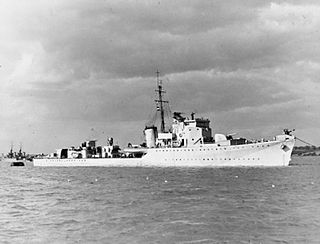
The second HMS Hambledon was a Hunt-class destroyer of the Royal Navy in commission from 1940 to 1945. She was a member of the first subgroup of the class, and saw service throughout World War II.
HMS Blencathra (L24) was a Hunt-class destroyer of the Royal Navy in commission from 1940 to 1948. She was a member of the first subgroup of the class, and saw service through most of World War II.

The second HMS Exmoor (L08), ex-HMS Burton, was a Hunt-class destroyer of the Royal Navy in commission from 1941 to 1945. She was a member of the second subgroup of the class, and saw service during much of World War II. She later served in the Royal Danish Navy as HDMS Valdemar Sejr.

HMS Wishart (D67) was a Modified W-class destroyer of the British Royal Navy that saw service in World War II. She spent most of her wartime career based at Gibraltar, engaged in convoy defence, but also served in various naval and military operations in the Mediterranean Sea.
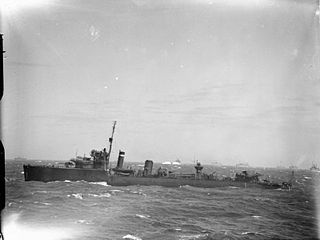
HMS Walker (D27) was a W-class destroyer of the British Royal Navy that saw service in the final months of World War I, in the Russian Civil War and in World War II.

The fourth HMS Volunteer (D71), later I71, was a Modified W-class destroyer of the British Royal Navy that saw service in World War II.

HMS Whitehall, pennant number D94, later I94, was a Modified W-class destroyer of the British Royal Navy that saw service in the Second World War.

The second HMS Wivern, was a Modified W-class destroyer of the British Royal Navy that saw service in World War II.





















